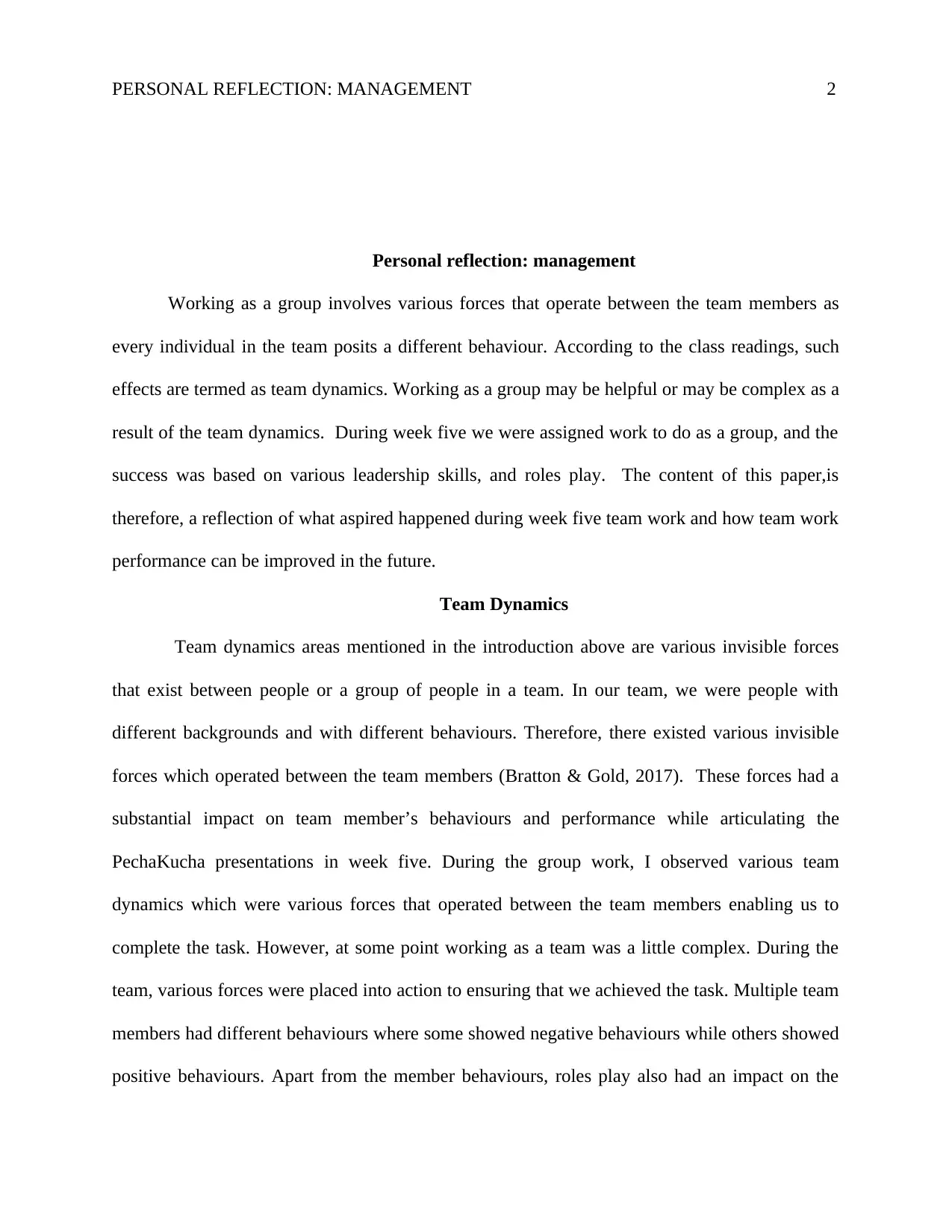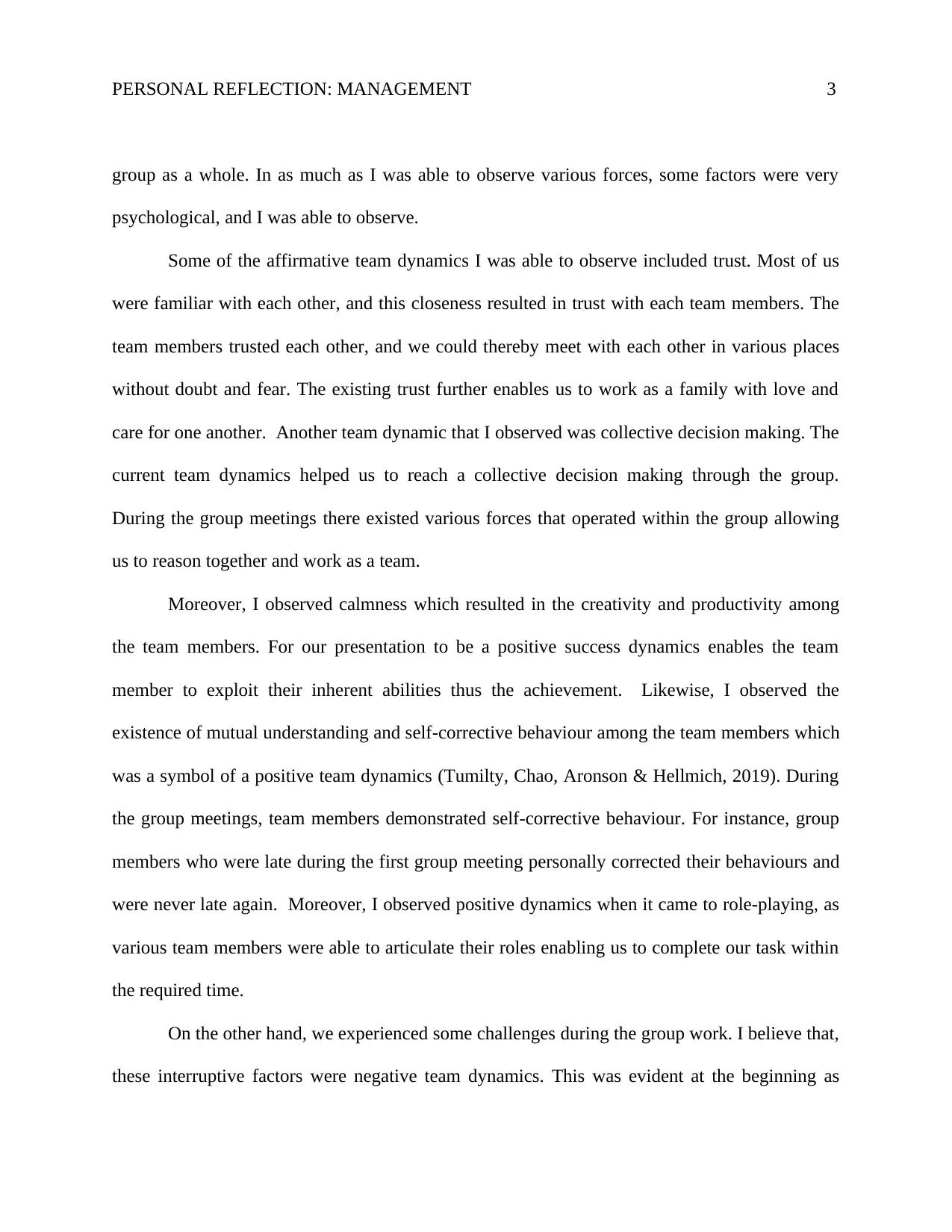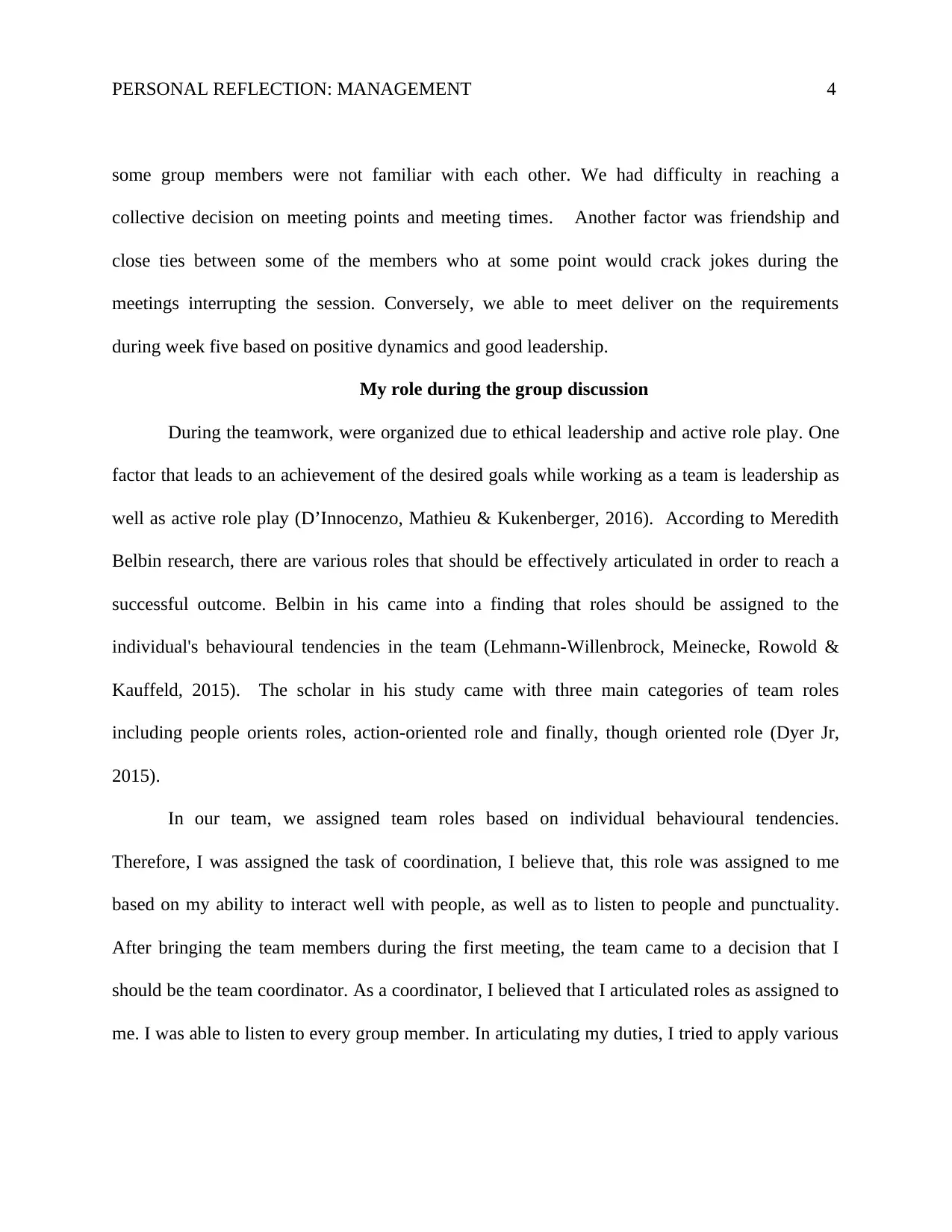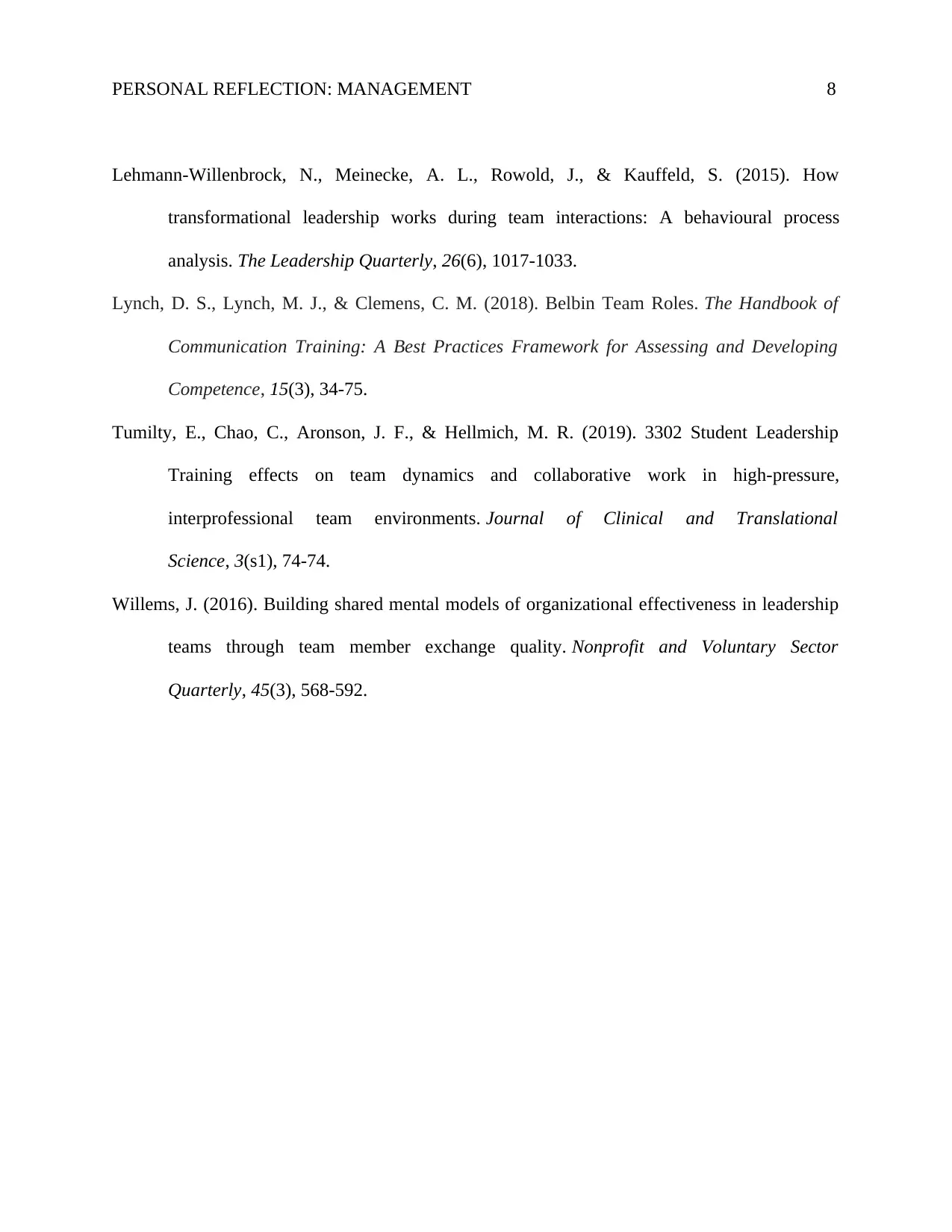Critical Reflective Report: Management in Team Dynamics
VerifiedAdded on 2023/03/23
|8
|2166
|42
Report
AI Summary
This report is a critical reflection on a student's experience in a team-based PechaKucha presentation project, as part of the Introduction to Management course (MANM4000). The student analyzes the team dynamics, including both positive aspects like trust and collective decision-making, and negative aspects like communication issues and interpersonal challenges. The report details the student's role as a coordinator, discussing the application of leadership skills and the challenges faced. The student connects the experiences to relevant academic literature, particularly focusing on team roles and leadership theories, referencing works by Bratton & Gold, Belbin, and others. The report concludes with recommendations for improving team performance in the future, such as establishing a clear team charter, enhancing communication, and implementing quick problem-solving strategies. The analysis incorporates organizational examples and a thorough use of Harvard referencing. The assignment meets the requirements of the assignment brief, including a minimum of 10 references and critical evaluation of the team dynamics and leadership principles.

Running head: PERSONAL REFLECTION: MANAGEMENT 1
Personal Reflection: Management
By (Student’s Name)
Institutional Affiliation
Personal Reflection: Management
By (Student’s Name)
Institutional Affiliation
Paraphrase This Document
Need a fresh take? Get an instant paraphrase of this document with our AI Paraphraser

PERSONAL REFLECTION: MANAGEMENT 2
Personal reflection: management
Working as a group involves various forces that operate between the team members as
every individual in the team posits a different behaviour. According to the class readings, such
effects are termed as team dynamics. Working as a group may be helpful or may be complex as a
result of the team dynamics. During week five we were assigned work to do as a group, and the
success was based on various leadership skills, and roles play. The content of this paper,is
therefore, a reflection of what aspired happened during week five team work and how team work
performance can be improved in the future.
Team Dynamics
Team dynamics areas mentioned in the introduction above are various invisible forces
that exist between people or a group of people in a team. In our team, we were people with
different backgrounds and with different behaviours. Therefore, there existed various invisible
forces which operated between the team members (Bratton & Gold, 2017). These forces had a
substantial impact on team member’s behaviours and performance while articulating the
PechaKucha presentations in week five. During the group work, I observed various team
dynamics which were various forces that operated between the team members enabling us to
complete the task. However, at some point working as a team was a little complex. During the
team, various forces were placed into action to ensuring that we achieved the task. Multiple team
members had different behaviours where some showed negative behaviours while others showed
positive behaviours. Apart from the member behaviours, roles play also had an impact on the
Personal reflection: management
Working as a group involves various forces that operate between the team members as
every individual in the team posits a different behaviour. According to the class readings, such
effects are termed as team dynamics. Working as a group may be helpful or may be complex as a
result of the team dynamics. During week five we were assigned work to do as a group, and the
success was based on various leadership skills, and roles play. The content of this paper,is
therefore, a reflection of what aspired happened during week five team work and how team work
performance can be improved in the future.
Team Dynamics
Team dynamics areas mentioned in the introduction above are various invisible forces
that exist between people or a group of people in a team. In our team, we were people with
different backgrounds and with different behaviours. Therefore, there existed various invisible
forces which operated between the team members (Bratton & Gold, 2017). These forces had a
substantial impact on team member’s behaviours and performance while articulating the
PechaKucha presentations in week five. During the group work, I observed various team
dynamics which were various forces that operated between the team members enabling us to
complete the task. However, at some point working as a team was a little complex. During the
team, various forces were placed into action to ensuring that we achieved the task. Multiple team
members had different behaviours where some showed negative behaviours while others showed
positive behaviours. Apart from the member behaviours, roles play also had an impact on the

PERSONAL REFLECTION: MANAGEMENT 3
group as a whole. In as much as I was able to observe various forces, some factors were very
psychological, and I was able to observe.
Some of the affirmative team dynamics I was able to observe included trust. Most of us
were familiar with each other, and this closeness resulted in trust with each team members. The
team members trusted each other, and we could thereby meet with each other in various places
without doubt and fear. The existing trust further enables us to work as a family with love and
care for one another. Another team dynamic that I observed was collective decision making. The
current team dynamics helped us to reach a collective decision making through the group.
During the group meetings there existed various forces that operated within the group allowing
us to reason together and work as a team.
Moreover, I observed calmness which resulted in the creativity and productivity among
the team members. For our presentation to be a positive success dynamics enables the team
member to exploit their inherent abilities thus the achievement. Likewise, I observed the
existence of mutual understanding and self-corrective behaviour among the team members which
was a symbol of a positive team dynamics (Tumilty, Chao, Aronson & Hellmich, 2019). During
the group meetings, team members demonstrated self-corrective behaviour. For instance, group
members who were late during the first group meeting personally corrected their behaviours and
were never late again. Moreover, I observed positive dynamics when it came to role-playing, as
various team members were able to articulate their roles enabling us to complete our task within
the required time.
On the other hand, we experienced some challenges during the group work. I believe that,
these interruptive factors were negative team dynamics. This was evident at the beginning as
group as a whole. In as much as I was able to observe various forces, some factors were very
psychological, and I was able to observe.
Some of the affirmative team dynamics I was able to observe included trust. Most of us
were familiar with each other, and this closeness resulted in trust with each team members. The
team members trusted each other, and we could thereby meet with each other in various places
without doubt and fear. The existing trust further enables us to work as a family with love and
care for one another. Another team dynamic that I observed was collective decision making. The
current team dynamics helped us to reach a collective decision making through the group.
During the group meetings there existed various forces that operated within the group allowing
us to reason together and work as a team.
Moreover, I observed calmness which resulted in the creativity and productivity among
the team members. For our presentation to be a positive success dynamics enables the team
member to exploit their inherent abilities thus the achievement. Likewise, I observed the
existence of mutual understanding and self-corrective behaviour among the team members which
was a symbol of a positive team dynamics (Tumilty, Chao, Aronson & Hellmich, 2019). During
the group meetings, team members demonstrated self-corrective behaviour. For instance, group
members who were late during the first group meeting personally corrected their behaviours and
were never late again. Moreover, I observed positive dynamics when it came to role-playing, as
various team members were able to articulate their roles enabling us to complete our task within
the required time.
On the other hand, we experienced some challenges during the group work. I believe that,
these interruptive factors were negative team dynamics. This was evident at the beginning as
⊘ This is a preview!⊘
Do you want full access?
Subscribe today to unlock all pages.

Trusted by 1+ million students worldwide

PERSONAL REFLECTION: MANAGEMENT 4
some group members were not familiar with each other. We had difficulty in reaching a
collective decision on meeting points and meeting times. Another factor was friendship and
close ties between some of the members who at some point would crack jokes during the
meetings interrupting the session. Conversely, we able to meet deliver on the requirements
during week five based on positive dynamics and good leadership.
My role during the group discussion
During the teamwork, were organized due to ethical leadership and active role play. One
factor that leads to an achievement of the desired goals while working as a team is leadership as
well as active role play (D’Innocenzo, Mathieu & Kukenberger, 2016). According to Meredith
Belbin research, there are various roles that should be effectively articulated in order to reach a
successful outcome. Belbin in his came into a finding that roles should be assigned to the
individual's behavioural tendencies in the team (Lehmann-Willenbrock, Meinecke, Rowold &
Kauffeld, 2015). The scholar in his study came with three main categories of team roles
including people orients roles, action-oriented role and finally, though oriented role (Dyer Jr,
2015).
In our team, we assigned team roles based on individual behavioural tendencies.
Therefore, I was assigned the task of coordination, I believe that, this role was assigned to me
based on my ability to interact well with people, as well as to listen to people and punctuality.
After bringing the team members during the first meeting, the team came to a decision that I
should be the team coordinator. As a coordinator, I believed that I articulated roles as assigned to
me. I was able to listen to every group member. In articulating my duties, I tried to apply various
some group members were not familiar with each other. We had difficulty in reaching a
collective decision on meeting points and meeting times. Another factor was friendship and
close ties between some of the members who at some point would crack jokes during the
meetings interrupting the session. Conversely, we able to meet deliver on the requirements
during week five based on positive dynamics and good leadership.
My role during the group discussion
During the teamwork, were organized due to ethical leadership and active role play. One
factor that leads to an achievement of the desired goals while working as a team is leadership as
well as active role play (D’Innocenzo, Mathieu & Kukenberger, 2016). According to Meredith
Belbin research, there are various roles that should be effectively articulated in order to reach a
successful outcome. Belbin in his came into a finding that roles should be assigned to the
individual's behavioural tendencies in the team (Lehmann-Willenbrock, Meinecke, Rowold &
Kauffeld, 2015). The scholar in his study came with three main categories of team roles
including people orients roles, action-oriented role and finally, though oriented role (Dyer Jr,
2015).
In our team, we assigned team roles based on individual behavioural tendencies.
Therefore, I was assigned the task of coordination, I believe that, this role was assigned to me
based on my ability to interact well with people, as well as to listen to people and punctuality.
After bringing the team members during the first meeting, the team came to a decision that I
should be the team coordinator. As a coordinator, I believed that I articulated roles as assigned to
me. I was able to listen to every group member. In articulating my duties, I tried to apply various
Paraphrase This Document
Need a fresh take? Get an instant paraphrase of this document with our AI Paraphraser

PERSONAL REFLECTION: MANAGEMENT 5
leadership skills. Since my work involved assigning responsibilities to other group members, I
had to use skills to be fair and just.
Therefore, I decide to be manipulative while articulating my duties to convince the team
members towards what they perceive to be the right and just. On the other hand in as much as I
tried my best while undertaking my role, I had some challenges which arose due to negative
dynamics such as withdrawal and excessive deference to authority as some members always
agreed with me while others withdrew from decision making. This was a challenge which I had
to employ creativity to overcome.
Measures to improve capable team performance
After the evaluation of the team dynamics and team roleplay, I have realized that there
are some challenges that we faced as a team that could be solved for better performance in the
future. Therefore, for the team to overcome the changelings we encountered during the group,
the following could be implemented for better performance.
Creation and enhancement of team charter and culture: for better performance in the
future and improve team dynamics, their team should have a clear charter containing roles and
vividly defined roles which could motivate the group as well as keeping the team focused
(Willems, 2016). Moreover, the team should develop a culture, and that is focused and
supportive to the team well-being. As noted during our teamwork, there is a need for group
members to trust and respect each other's diversity. The enhanced culture and charter will enable
the team to work freely with each other, create and open communication, chance to share ideas
as well as hold team members who are not able to articulate their roles in time to account
(Barnett & Weidenfeller, 2016).
leadership skills. Since my work involved assigning responsibilities to other group members, I
had to use skills to be fair and just.
Therefore, I decide to be manipulative while articulating my duties to convince the team
members towards what they perceive to be the right and just. On the other hand in as much as I
tried my best while undertaking my role, I had some challenges which arose due to negative
dynamics such as withdrawal and excessive deference to authority as some members always
agreed with me while others withdrew from decision making. This was a challenge which I had
to employ creativity to overcome.
Measures to improve capable team performance
After the evaluation of the team dynamics and team roleplay, I have realized that there
are some challenges that we faced as a team that could be solved for better performance in the
future. Therefore, for the team to overcome the changelings we encountered during the group,
the following could be implemented for better performance.
Creation and enhancement of team charter and culture: for better performance in the
future and improve team dynamics, their team should have a clear charter containing roles and
vividly defined roles which could motivate the group as well as keeping the team focused
(Willems, 2016). Moreover, the team should develop a culture, and that is focused and
supportive to the team well-being. As noted during our teamwork, there is a need for group
members to trust and respect each other's diversity. The enhanced culture and charter will enable
the team to work freely with each other, create and open communication, chance to share ideas
as well as hold team members who are not able to articulate their roles in time to account
(Barnett & Weidenfeller, 2016).

PERSONAL REFLECTION: MANAGEMENT 6
Quick problem solving: As a team leader, one should conduct a rapid diagnosis to know
each of the team members. As mentioned above, there are few areas where I had a challenge in
articulating my role, based on the fact that I was unable to know my team members early enough
(Lynch, Lynch & Clemens, 2018). This resulted in leaders being unable to solve problems such
as member withdrawal and fear to confront the leaders. For that reason, I believe that for our
team to perform better than we did in week five, as leaders we should learn to solve problems
quickly. Markedly, when it comes to problems solving, the leader should be aware of each team
member's behaviour (Lehmann-Willenbrock, Beck & Kauffeld, 2016).
Implementation of effective communication: based on the experience I gained through
week five group work, I believe that effective communication is required for success. Therefore,
for the team to perform better in the future, as leaders we must effectively communicate to the
group members and also understand what they expect from us. The success of a team is linked to
the understanding of the team objectives just as in our case. Moreover, each member should be
well aware of their roles (Driskell, Driskell, Burke & Salas, 2017). This is also linked to
communication. As a leader, I have learned that the leaders should assume defined individual
responsibilities to each member. To this manner, I recommend better communication strategies
and distinct roles as well as responsibilities for each member.
Conclusion
In conclusion, teamwork is necessary for quick articulation of tasks and collaborative
production. However, there exist various psychological forces operating between the team
members known as team dynamics. The team dynamics can either be positive or negative.
Through the articulation of week five task, I was assigned the coordination role I witnessed both
Quick problem solving: As a team leader, one should conduct a rapid diagnosis to know
each of the team members. As mentioned above, there are few areas where I had a challenge in
articulating my role, based on the fact that I was unable to know my team members early enough
(Lynch, Lynch & Clemens, 2018). This resulted in leaders being unable to solve problems such
as member withdrawal and fear to confront the leaders. For that reason, I believe that for our
team to perform better than we did in week five, as leaders we should learn to solve problems
quickly. Markedly, when it comes to problems solving, the leader should be aware of each team
member's behaviour (Lehmann-Willenbrock, Beck & Kauffeld, 2016).
Implementation of effective communication: based on the experience I gained through
week five group work, I believe that effective communication is required for success. Therefore,
for the team to perform better in the future, as leaders we must effectively communicate to the
group members and also understand what they expect from us. The success of a team is linked to
the understanding of the team objectives just as in our case. Moreover, each member should be
well aware of their roles (Driskell, Driskell, Burke & Salas, 2017). This is also linked to
communication. As a leader, I have learned that the leaders should assume defined individual
responsibilities to each member. To this manner, I recommend better communication strategies
and distinct roles as well as responsibilities for each member.
Conclusion
In conclusion, teamwork is necessary for quick articulation of tasks and collaborative
production. However, there exist various psychological forces operating between the team
members known as team dynamics. The team dynamics can either be positive or negative.
Through the articulation of week five task, I was assigned the coordination role I witnessed both
⊘ This is a preview!⊘
Do you want full access?
Subscribe today to unlock all pages.

Trusted by 1+ million students worldwide

PERSONAL REFLECTION: MANAGEMENT 7
negative and positive team dynamics. Where positive dynamics enabled us to complete the
assignment within the time; on the other hand, there were various challenges we faced as team
members. However, through strong leadership and active roles play we were able to achieve the
desired objectives. Therefore, for this reason, I have suggested various strategies which when
applied will result in better performance in the future such as effective communication, charters,
enhanced team culture and quick problems solving.
References
Barnett, R. C., & Weidenfeller, N. K. (2016). Shared leadership and team
performance. Advances in Developing Human Resources, 18(3), 334-351.
Bratton, J., & Gold, J. (2017). Human resource management: theory and practice (pp.35-65).
Palgrave.
D’Innocenzo, L., Mathieu, J. E., & Kukenberger, M. R. (2016). A meta-analysis of different
forms of shared leadership–team performance relations. Journal of Management, 42(7),
1964-1991.
Driskell, T., Driskell, J. E., Burke, C. S., & Salas, E. (2017). Team roles: A review and
integration. Small Group Research, 48(4), 482-511.
Dyer Jr, W. G. (2015). Team building. Wiley Encyclopedia of Management, 1-2.
Lehmann-Willenbrock, N., Beck, S. J., & Kauffeld, S. (2016). Emergent team roles in
organizational meetings: Identifying communication patterns via cluster
analysis. Communication Studies, 67(1), 37-57.
negative and positive team dynamics. Where positive dynamics enabled us to complete the
assignment within the time; on the other hand, there were various challenges we faced as team
members. However, through strong leadership and active roles play we were able to achieve the
desired objectives. Therefore, for this reason, I have suggested various strategies which when
applied will result in better performance in the future such as effective communication, charters,
enhanced team culture and quick problems solving.
References
Barnett, R. C., & Weidenfeller, N. K. (2016). Shared leadership and team
performance. Advances in Developing Human Resources, 18(3), 334-351.
Bratton, J., & Gold, J. (2017). Human resource management: theory and practice (pp.35-65).
Palgrave.
D’Innocenzo, L., Mathieu, J. E., & Kukenberger, M. R. (2016). A meta-analysis of different
forms of shared leadership–team performance relations. Journal of Management, 42(7),
1964-1991.
Driskell, T., Driskell, J. E., Burke, C. S., & Salas, E. (2017). Team roles: A review and
integration. Small Group Research, 48(4), 482-511.
Dyer Jr, W. G. (2015). Team building. Wiley Encyclopedia of Management, 1-2.
Lehmann-Willenbrock, N., Beck, S. J., & Kauffeld, S. (2016). Emergent team roles in
organizational meetings: Identifying communication patterns via cluster
analysis. Communication Studies, 67(1), 37-57.
Paraphrase This Document
Need a fresh take? Get an instant paraphrase of this document with our AI Paraphraser

PERSONAL REFLECTION: MANAGEMENT 8
Lehmann-Willenbrock, N., Meinecke, A. L., Rowold, J., & Kauffeld, S. (2015). How
transformational leadership works during team interactions: A behavioural process
analysis. The Leadership Quarterly, 26(6), 1017-1033.
Lynch, D. S., Lynch, M. J., & Clemens, C. M. (2018). Belbin Team Roles. The Handbook of
Communication Training: A Best Practices Framework for Assessing and Developing
Competence, 15(3), 34-75.
Tumilty, E., Chao, C., Aronson, J. F., & Hellmich, M. R. (2019). 3302 Student Leadership
Training effects on team dynamics and collaborative work in high-pressure,
interprofessional team environments. Journal of Clinical and Translational
Science, 3(s1), 74-74.
Willems, J. (2016). Building shared mental models of organizational effectiveness in leadership
teams through team member exchange quality. Nonprofit and Voluntary Sector
Quarterly, 45(3), 568-592.
Lehmann-Willenbrock, N., Meinecke, A. L., Rowold, J., & Kauffeld, S. (2015). How
transformational leadership works during team interactions: A behavioural process
analysis. The Leadership Quarterly, 26(6), 1017-1033.
Lynch, D. S., Lynch, M. J., & Clemens, C. M. (2018). Belbin Team Roles. The Handbook of
Communication Training: A Best Practices Framework for Assessing and Developing
Competence, 15(3), 34-75.
Tumilty, E., Chao, C., Aronson, J. F., & Hellmich, M. R. (2019). 3302 Student Leadership
Training effects on team dynamics and collaborative work in high-pressure,
interprofessional team environments. Journal of Clinical and Translational
Science, 3(s1), 74-74.
Willems, J. (2016). Building shared mental models of organizational effectiveness in leadership
teams through team member exchange quality. Nonprofit and Voluntary Sector
Quarterly, 45(3), 568-592.
1 out of 8
Related Documents
Your All-in-One AI-Powered Toolkit for Academic Success.
+13062052269
info@desklib.com
Available 24*7 on WhatsApp / Email
![[object Object]](/_next/static/media/star-bottom.7253800d.svg)
Unlock your academic potential
Copyright © 2020–2025 A2Z Services. All Rights Reserved. Developed and managed by ZUCOL.




